Neurointervention.
2019 Mar;14(1):63-67. 10.5469/neuroint.2018.01102.
Objective Assessment of Arterial Steal Phenomenon in Direct Carotid Cavernous Fistula Using 2D Parametric Parenchymal Blood Flow Analysis
- Affiliations
-
- 1Department of Neurosurgery, Rush University Medical Center, Chicago, IL, USA. Nada.neurology@gmail.com
- 2Department of Neurology, Mansoura University, Mansoura, Egypt.
- 3Siemens Medical Solutions, Malvern, PA, USA.
- KMID: 2446784
- DOI: http://doi.org/10.5469/neuroint.2018.01102
Abstract
- The aim of the study is to evaluate the hemodynamic changes and the parenchymal perfusion associated with carotid cavernous fistulas before and after embolization using two-dimensional (2D) parenchymal blood flow analysis. A 15-year-old boy presented with 2-month history of progressive right eye proptosis, chemosis, and diplopia after a motor vehicle accident. Intracranial liquid embolization using Onyx-18 through the inferior petrosal approach was done with balloon protection at the opening of the fistula in the internal carotid artery, resulting in complete occlusion of the fistula. Parenchymal blood flow analysis was done before and immediately after embolization. 2D parametric parenchymal blood flow analysis is newly introduced software that can provide data cannot be conveyed by conventional digital subtraction angiography alone. The software allows for objective assessment of the arterial steal and the parenchymal perfusion both pre, and post-embolization. Pre-embolization assessment may influence the therapeutic decision, while post-embolization assessment can evaluate the treatment efficacy.
Keyword
MeSH Terms
Figure
Reference
-
1. Costa VP, Molnar LJ, Cerri GG. Diagnosing and monitoring carotid cavernous fistulas with color Doppler imaging. J Clin Ultrasound. 1997; 25:448–452.
Article2. Barrow DL, Spector RH, Braun IF, Landman JA, Tindall SC, Tindall GT. Classification and treatment of spontaneous carotid-cavernous sinus fistulas. J Neurosurg. 1985; 62:248–256.
Article3. Chen YW, Jeng JS, Liu HM, Hwang BS, Lin WH, Yip PK. Carotid and transcranial color-coded duplex sonography in different types of carotid-cavernous fistula. Stroke. 2000; 31:701–706.
Article4. Yanik B, Conkbayir I, Oztürk M, Acaroglu G, Hekimoglu B. Partial steal phenomenon in the ophthalmic artery due to a direct carotid-cavernous sinus fistula: orbital color Doppler ultrasonographic findings. J Ultrasound Med. 2003; 22:1107–1110.5. Choi HY, Newman NJ, Biousse V, Hill DC, Costarides AP. Serous retinal detachment following carotid-cavernous fistula. Br J Ophthalmol. 2006; 90:1440.
Article6. Chi CT, Nguyen D, Duc VT, Chau HH, Son VT. Direct traumatic carotid cavernous fistula: angiographic classification and treatment strategies study of 172 cases. Interv Neuroradiol. 2014; 20:461–475.
Article7. Elsaid N, Saied A, Joshi K, Nelson J, Baumgart J, Lopes D. 2D parametric parenchymal blood flow as a predictor of the hemorrhagic events after endovascular treatment of acute ischemic stroke: a single-center retrospective study. Interv Neurol. 2018; 7:522–532.
Article8. Joshi DK, Singh DD, Garg DD, Singh DH, Tandon DM. Assessment of clinical improvement in patients undergoing endovascular coiling in traumatic carotid cavernous fistulas. Clin Neurol Neurosurg. 2016; 149:46–54.
Article9. Hayashi K, Suyama K, Nagata I. Traumatic carotid cavernous fistula complicated with intracerebral hemorrhage. Neurol Med Chir (Tokyo). 2011; 51:214–216.10. Joshi KC, Singh D, Tandon MS. Intrafistula pressure measurement in traumatic carotid cavernous fistulas--key to increasing safety and effectiveness of endovascular coiling. Acta Neurochir (Wien). 2014; 156:1695–1700.11. Kliewer MA, Hertzberg BS, Kim DH, Bowie JD, Courneya DL, Carroll BA. Vertebral artery Doppler waveform changes indicating subclavian steal physiology. Am J Roentgenol. 2000; 174:815–819.
Article
- Full Text Links
- Actions
-
Cited
- CITED
-
- Close
- Share
- Similar articles
-
- Regional Cerebral Blood Flow Changes in Traumatic Carotid Cavernous Fistula During Trapping Procedure: Case Study, Preliminary Report
- Direct Microsurgical Repair of Traumatic Carotid-Cavernous Fistula
- Delayed Spontaneous Thrombosis of Neglected Direct Carotid-Cavernous Fistula: A Case Report
- Central Retinal Vein Occlusion During Embolization for Carotid Cavernous Sinus Fistula
- A Case of Carotid Cavernous Fistula Treated by Muscle and Polyurethane Foam Embolization: Case Report




